All posts by Gary Stockton
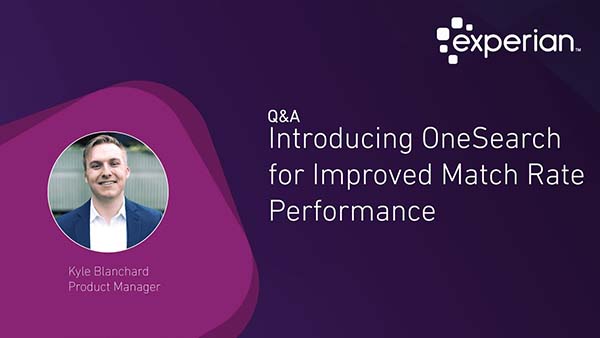
We recently sat down with Kyle Blanchard, Product Manager with Business Information Services to ask him a few questions about Experian's improved OneSearch technology. What is OneSearch? OneSearch is a lot of things at its core. OneSearch is the ability for a customer to find a business, but the story of OneSearch is much bigger than that. OneSearch is Experian's technological advancement and journey on how we're bringing all of our innovations to drive improvements for our customers. So, our customers can find businesses today, but at Experian we had to ask the question, how can we make this better? And with OneSearch, we're providing the ability for our customers to find businesses faster, and for them to find a more exact match and a more precise business every single time. What should Experian clients expect? Our clients can expect a variety of changes. Those changes won't come in terms of the products or services you're using today, but more about the experience you're having. So whether you're using BusinessIQ, or you're getting files in batch, the only experience difference you're going to feel is you're going to get better match results, more match results, and you're going to get them at a faster speed. So your experience is going to improve. This is going to be free of charge. This is just an internal improvement that we're making for you. But, every way you interface with our applications or your services will not change at all. Why does OneSearch matter to our clients? This matters a lot to our clients. Their first experience and every experience they have with us starts with finding the right business. So, we stepped back and we asked ourselves, how can we improve this experience for our customers and how can we make it better? And so, we looked at all technologies available and we did an evaluation, and what we had was a deterministic solution but where we really needed to be was a probabilistic one. But the investment that the company or that we needed to make to get there is significant. But we saw that this is an important investment to make because of the improvements that it can drive for our customers, and the improvements it could drive for our customers are wide and varied. Whether it be an improved ROI because you're finding more businesses, or a faster processing time so you can do more jobs even quicker. Why is Experian investing in innovation and technology? Experian is investing in innovation and technology for two reasons. One, it's part of our culture, we're always investing in innovation and technology, whether it be this probabilistic search match algorithm, whether it be machine learning or whether it be A.I. We're always trying to innovate and always trying to drive new best practices in technology. Finally, we know the importance from our customer perspective. This is fundamental to their experience. And not only that, we recently partnered with Forrester to do a research study and found that over 85% of risk managers are looking to improve their risk management practices. 75% of those are willing to invest and purchase a solution within the next year. So we know how important this is to our customers, and the only way to get there is to innovate and always drive new technology. Learn More About OneSearch
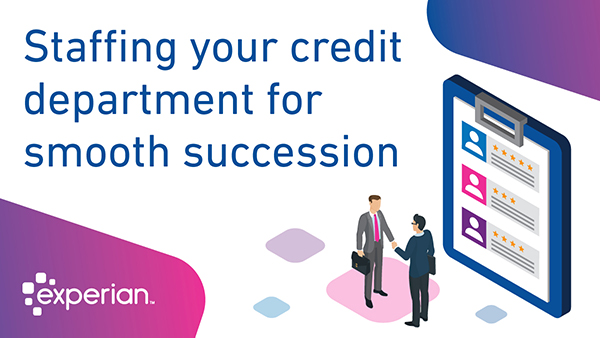
The credit industry works very differently than it did even a few years ago. In recent years, new technology and the availability of analytics means that credit departments have much more information to make decisions. When both commercial and consumer data is used together, departments unlock a lot of powerful data that can be combined for more accurate decisions. However, some credit departments have not changed their processes and staffing structure. By using the traditional approaches even with new technology and data, credit departments are not able to see all of the possible benefits. I recently spoke on a panel of credit management executives at the High Radius Conference. During the talk, we touched on this topic and talked afterwards about what credit organizations need to do. Jan Minniti, Senior National Account Executive with the National Association of Credit Management mentioned that while many large organizations are using automation, even smaller shops can benefit as well. But her larger point was in order to transform, organizations must change the skill sets that they are recruiting, and expand training offered to current employees. Here are a few keys to help your organization transition to modern credit management: 1. Understand the recent evolution of credit models and technology As Minniti pointed out, we started out with general payment score models that were applied to everyone. However, today more specific models are available (for example, specific to an industry), so you can choose the best model depending on who you are selling to. These new models move us into a new generation where instead of making gut feel decisions or spreadsheets to track data, we can use statistics to not only assess risk, but also assign credit line increases. These scores and credit lines can then be fed to automated tools to manage the order-to-cash process. Even more importantly, we can use automated technology for account management strategies, which increase efficiency, maximize account potential and reduce fraud. In our experience at Experian, we have evidence that machine learning reduces manual reviews by as much as 74 percent. 2. Learn how credit managers can revise their role and processes Research recent changes in the financial services industry for inspiration on what is possible and how to help your department get to the next generation. Typically the FinTechs and large banks are on the leading edge of advances in risk management. By starting with analytics, the financial industry has driven a lot of innovation and change. They have also focused on data management to evolve to a frictionless environment. Think of how your company can incorporate these changes. But most importantly, how you as a credit manager can introduce and drive the change. 3. Revise the credit manager role to include more strategy Instead of shrinking from the change out of concern that technology will replace your role, credit managers need to lead the change. Start by learning what’s possible with regards to both technology and data. Share it with other credit managers and leadership to help your company be an early adopter. But, be careful not to fall into “shiny object syndrome”, where you use technology just because its available, even though it might not yet have the features you need. A solution in search of a problem is always a questionable approach. Minniti says that she knows changing the roles is challenging because it is a big shift and credit is not typically the shiny, new area of the company. However, to reduce risks and impact change, credit managers must seek greater visibility with the C-Suite. “Credit managers should educate management by using reports to show the importance to your company. Use data to show how much money you are saving the company,” says Minniti. “It’s also important to talk about automation, which actually helps credit managers stay relevant instead of replacing their jobs.” Having an automated credit strategy is also a great way to manage in times of turnover, or in trying to up level expertise. 4. Revising staffing and hiring guidelines Minniti says it starts by picking good analysts who can replace you. “If you staff with people who listen to what the machine learning is saying, but don't have the ability to think beyond that then who fills your shoes when you move on? What happens to the credit department?,” says Minniti. “We will always need people to tell the machine what to do, be able to adjust the model when the economy changes.” One of the biggest reasons that many managers and departments are resisting technology is fear of being replaced. This simply isn’t going to happen. Without the experience and background, credit models quickly decay. It is impossible to turn over all of the thinking behind credit decisions to machines. Someone needs to be there to manage the ongoing performance of the models, and make sure the analytics track with changes in the marketplace. Credit departments that take initiative to lead the change, to use the new technology and models, will demonstrate their value to their organization. By using automation and machine learning, the credit department becomes more valuable to the organization instead of less. By proactively managing the change and taking the lead, you can set your department on the right path to lead the transformation of your company as well as the credit industry.
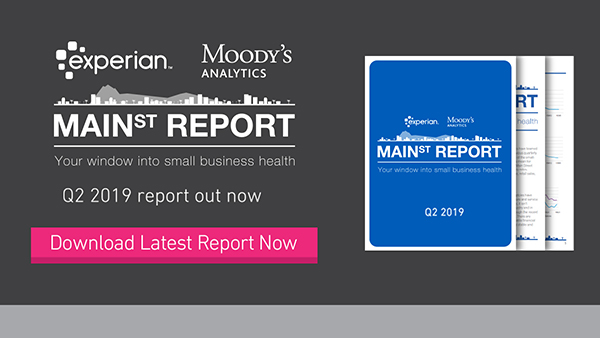
Experian and Moody’s Analytics have just released the Q2 2019 Main Street Report. The report brings deep insight into the overall financial well-being of the small-business landscape, as well as providing commentary on what certain trends mean for lenders and small businesses. Q2 Highlights In spite of business confidence in the second quarter, shaken by talk of trade war escalation, small businesses got a helping hand from seasonal factors that combined to push delinquency rates down. Delinquency rates for businesses with fewer than 100 employees fell in the second quarter, decreasing the 31–90 days past due rate from 1.74 percent to 1.64 percent for the quarter. But agriculture’s problems continued as weather and trade conditions continued to weigh on small farms. These factors won’t be as helpful in the third quarter, so fundamentals or confidence will need to improve to propel performance and growth forward. Bankruptcies ticked up ever so slightly again in the second quarter coming in at over 16 basis points. The most recent data available, from Q4 2018, indicates an establishment growth rate of 2.3%. Enough of these new businesses will seek credit to ensure that, combined with existing borrowers, balances look set to grow for some time. Overall, small businesses continue to display little to no signs of broad-based weakness. What weakness exists is fairly well confined at either the regional or industry level, and the solid performance that has been the norm for the last several quarters looks set to continue. Watch Webinar Recording Experian and Moody's Analytics go in-depth on the Q2 2019 Main Street Report in the below webinar.
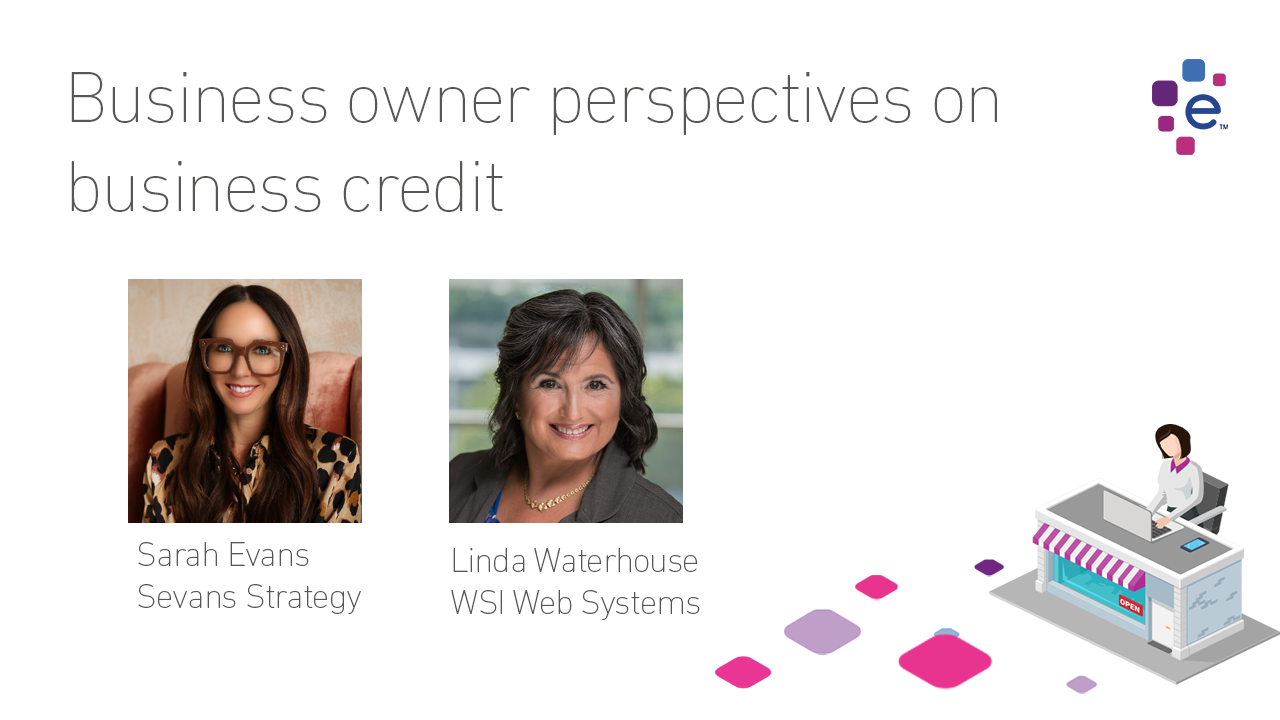
Experian has just released the Women in Business credit study, which is a three year study of around 2.8 million credit files for small business owners, and one of the key findings in this study was that, women business owners in particular, are reliant upon personal forms of credit, and they may be at a disadvantage through this practice. So we wanted to talk to some women business owners about business credit. First up is Sara Evans from Sevans Strategy. Experian: Sarah, could you tell us a little bit about your business and how you got started in PR? Sarah Evans: Certainly, I was a PR major in college. And, when I originally graduated I was very interested in the nonprofit sector, so I went to work for the largest health care system in Illinois, and focused heavily on communications, internal comms and government relations. From there did some PR agency work and then became director of communications for a small community college. And throughout all of that it was at the time of emerging media or digital media and I was a bit far ahead of my nonprofit hat that I was wearing. So, at night I would go home and consult for companies and businesses who are ready to do emerging technologies, planned and implement them and essentially worked myself out of a job and have now had my company Sevens Strategy for the past 10 years focused specifically on digital PR? Experian: Do you rely on personal forms of credit for your business? Sarah Evans: I am completely self-funded. In fact, when I transitioned out of my traditional day job I had an amazing boss at the time. We did a three month exit strategy, so they could find my replacement. And so, I could also build up enough business, steady business to be able to move forward. And, because of that I believe I set myself up in a way that it has, it has done well. Experian: Have you ever run your business credit report? Sarah Evans: I haven't. Perhaps I should. I know Experian could probably help me with that. Experian: Well our study revealed that many women business owners will fund their operation through personal forms of credit. Is that something that surprises you? Sarah Evans: It doesn't surprise me, no. I think some of it is, for example when I decided to get into business for myself, I didn't have necessarily the business acumen or the background or a business degree. A lot of it I learned on the go. So, you take your habits or best practices that you may already use in your everyday life and just transition them over to business. I think a lot of it is learn as you go or finding and learning from industry experts that can help you do better. Experian: So do you think there's a need for additional resources around building strong credit and best practices in business credit? Sarah Evans: I think there is a huge opportunity and in fact if it already existed I would have had no idea. I also think it's important for this up and coming generation especially as we see an uptick in the rise of entrepreneurs. Every day we see new businesses and product ideas that are launching. There are prime candidates out there that may be great at honing an idea or bringing a business plan to life but not sure about the financial aspect of it. It'd be great to have a partner and a resource area where you could go to, and not just from the credit bureaus themselves or financial institutions themselves, but from trusted business resources who might work with them. So that I don't feel like I'm going all in on an institution that I may not have full trust in, but I might trust someone that they work with or that has used them already. Experian: Well thanks for coming on and sharing about your business Sarah. Sarah Evans: Thanks so much Gary. Experian: Well next we're going to speak to Linda Waterhouse and she is the owner of WSI, a digital agency. Linda, can you tell us what your business is primarily focused on right now? Linda Waterhouse: Yes, I am a digital marketing strategist, and I focus on helping professional women use LinkedIn for lead generation. Experian: Ok that's great. And so how long has your business been in business? Linda Waterhouse: My business. I've been running my business for about six years now. Experian: So how do you feel about taking on debt for your business? Linda Waterhouse: I have so far just invested our personal money rather than going outside to a bank or other lending facility to get a loan. Experian: So, can you tell us why you have used personal forms of funding for your business? Linda Waterhouse: I haven't really relied on like personal credit cards. I've delved into our long-term savings with the intent of paying it back. Part of that was because I thought that it was less expensive to not pay interest on that. All we would be losing is the interest that that money would be earning and since interest levels are low right now, I didn't think that that would be as significant as if I were to go out and get a loan, and I don't know what the interest rates are, you know, 5, 10 percent. So it seemed like a more economical way for me to start my business. Experian: And can you talk a little bit about the growth of your business? Linda Waterhouse: This year I decided that I was really going to focus on one social platform which is LinkedIn, and to help women business owners primarily learn how to use it for lead generation, because many people still think of LinkedIn as just for job searchers and recruiters. Experian: So Linda, have you run your own business credit report? Linda Waterhouse: Oh, you caught me. No, I haven't because I don't have any immediate plans to take a loan. So I have to say that I do not have any credit or I don't know what my credit score is. Experian: So, if there were resources on building and maintaining strong credit, would you take advantage of those resources? Linda Waterhouse: Yes. And I think taking people through the process would help starting or creating another opening another credit card is something that I've done personally? So, opening one for my business is very familiar and I can do it online. I have no idea how to do a business loan. I don't know which bank to pick. So, that's you know the unknown is always something that people are going to be wary of. Experian: Last question. What do you like most about being a business owner? Linda Waterhouse: The best part of being a business owner who works in digital or online is the fact that I can work from nearly anywhere. I recently accompanied my husband on a trip to Brussels in Amsterdam. He had work there, and I went with him and I could keep up with my work when I was there. So we were able to have a longer stay there than I would have been able to had I been tied to work here in New Jersey.
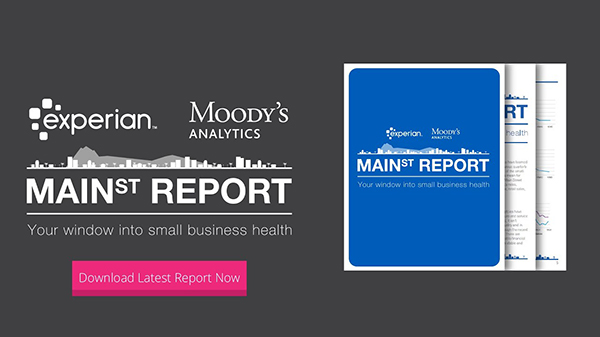
Experian and Moody’s Analytics have just released the Q1 2019 Main Street Report. The report brings deep insight into the overall financial well-being of the small-business landscape, as well as providing commentary on what certain trends mean for lenders and small businesses. In Q1 U.S. small businesses brushed off a government shutdown as stock markets recovered and income gains remained steady. Delinquency rates remained mostly stable, with pockets of weakness spread out among regions and industries, notably agriculture in the Great Lakes and manufacturing in the Southwest. Small firms seem to have simply shrugged off the headwinds of the first quarter and kept on with business as usual. Despite a fresh escalation in trade tensions, the year is starting off well with positive news coming from the areas presenting risks to the outlook. A dovish stance on interest rates from the Federal Reserve and room to grow in our housing market — 2019 is off to a strong start. Watch Webinar Recording - Q1 2019 Quarterly Business Credit Review Listen to the experts from Experian and Moody's Analytics go in-depth on insights revealed in the Q1 2019 Experian/Moody's Analytics Main Street Report.
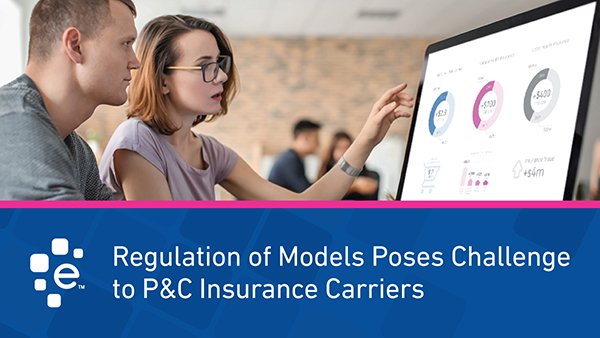
Serving commercial Property & Casualty insurers is a major objective of 3rd parties in the analytics and data space. This industry vertical is one in which standard credit tools already apply to the carrier’s challenge in managing claims risk; there is continued investment within and beyond the industry in developing innovative tools for this purpose. However, a smooth roll out of such tools at scale requires a comprehensive understanding of the regulatory process and its constraints. US Insurance industry- overall regulatory structure: Currently, US carriers are regulated primarily by the individual states, a result of the 1945 McCarran Ferguson Act (“MFA”). Less known is that the MFA was presaged by the Paul v Virginia decision (1869, later overturned by SCOTUS) that held that issuing an insurance policy was not a commercial transaction! [1]. Federal regulatory guidance, ultimately from the Office of the Controller of the Currency (OCC) and the Federal Reserve Board (FRB), is implemented via the National Association of Insurance Commissioners (“NAIC”; see below). NAIC organizes the insurance commissioners from all 50 states, Washington DC, and territories. NAIC maintains legislative databases, market conduct standards, industry financial reporting, conducts training, and many other functions. NAIC provides supervisory guidance for the use of models used to predict insurance loss risk. Among other functions, NAIC has created the Own Risk and Solvency Assessment (“ORSA”) framework which implements existing OCC and FRB guidance to the states. Capital reserves needed for solvency as well as business conduct -- including product definition and general business operations, licensing, maintaining a guaranty fund, underwriting, and rate setting-- are determined primarily by the states in which the carrier operates [2]. Today’s system of state-by-state regulation is more challenging than an equivalent centralized regulating body; insurance carriers operate increasingly online, driving the need for multi-state operations which in turn require multistate licensing and complex regulatory compliance. The average property liability firm has 16 state licenses, while the average life insurance carrier has 25. The coordination of state insurance laws, as well as many other quasi-governmental insurance industry functions, falls under the aegis of the NAIC. We will focus our discussion here on the regulation of risk models. How should third parties align the model building with regulatory requirements? Example 1: Basic filing and disclosure protocol: Responsibility to disclose to state regulators typically lies with the developer or the owner of the model. Disclosure responsibility for custom risk models built around the data of a specific client insurer resides with the insurer, while industry standard models used for multiple clients are typically disclosed by the model developer. Reporting and disclosure requirements vary by state. While the most central functions of interest by state regulators are underwriting and rate setting, any other use of models by insurers may be subject to regulatory disclosure. Models used to assess loss risk for rate setting or underwriting purposes are typically examined for discriminatory impact and use of prohibited data in addition to adequate risk performance and numerical stability. “Prohibited data” varies by state but may include certain data elements gleaned from in-state residents, federal crime data, certain credit data elements, traffic violations exceeding a specified age on the books, or other data; the section below deals with credit data. Finally, the requirement to disclose model details such as attributes and weightings also vary between states, and may require the developer to invoke trade secret status for the subject models to avoid disclosure to the public (implicit in many states). The adjudication of such claims is variable between states, as are all communications with regulators on this topic. Example 2: Use of consumer credit information to underwrite personal insurance policies: Using credit information in models to predict loss risk on personal insurance contracts also has a rich and extremely active history in the US. P&C insurers have generally found that credit risk and claims risk are positively correlated. They have used credit data on individual consumers to various degrees. Notably, the Consumer- Based Insurance Score (CBIS) employs consumer credit parameters and has been used across the insurance industry since 1993. Amid vigorous debate, states have seen active legislative attempts to restrict and define allowable use of consumer credit data by insurers. Credit information in some cases can outweigh a consumer’s driving record in setting rates- leading to the bitter but factual observation that excellent consumer credit can literally outweigh a DUI conviction in some states and conditions. In 2016 alone, the state legislative actions below were considered and/or enacted; note once again that the ability of individual states to regulate independently greatly complicates the picture for large carriers operating in multiple states: California, Hawaii, and Massachusetts do not appear in the table above. In those states, consumer credit information cannot be used to underwrite personal auto policies. Example 3: Reporting channel: State regulators typically require use of the System for Electronic Rate and Form Filing (“SERFF”) database maintained by NAIC for formal submissions: https://login.serff.com/serff/ What’s coming down the road? We have seen examples of the dependence of applicable insurance regulations on individual state laws; the mechanics of model development requires understanding and working with these restrictions. Basic filing and disclosure, permissible model variables, the proprietary status of model detail, and the use of certain consumer information (e.g., credit scores, driving records) are all aspects of risk models whose successful execution depends on understanding the widely variable set of existing state regulations. Several authors have cited the need for a shift in the underlying regulatory structure of the industry from state-based to a national system, citing the inefficiency of the licensing process and the true interstate nature of today’s distribution system. A centralized federal insurance regulatory body would simplify interstate compliance by carriers, but would also introduce other complications. However, it appears prudent in the near-term for 3rd parties developing models to gain awareness of, and streamline, current requirements for regulatory compliance at the state level. Conclusion: There is a considerable additional value that the next generation of models will contribute to the commercial P&C vertical. Insurers and 3rd party developers have demonstrated the applicability of their models and data reports, offering competitive added value with standard risk scores adapted from the credit domain. However, promoting these products more broadly and expanding the product offerings themselves into cyber risk, commercial linkages, and various other tools for insurers, the insurance industry faces efficiency hurdles from our 50-state regulatory framework. With any regulatory centralization unlikely near term, 3rd parties thus need to gain working fluency in NAIC and in the SERFF database, anticipate state-level documentation and disclosure requirements, and attain a level of familiarity with state regulatory machines that enables the management of the interests of their clients with confidence. How Experian can help you Experian provides analytical services for Property & Casualty as well as other insurance product verticals. To enable you to assess claims risk at the time of policy application (or renewal), we either apply standard risk models or develop custom risk models to your underwriting and rate-setting processes. To help you guard against cyber fraud, false identity, and reputation risk, we offer specialty products as well. We also offer special purpose, custom analyses on request, and we sell curated commercial data to your standards as well. References: [1] Brookings Institute. paper on future of regulation- Grace & Klein [2] Insurance Information Institute: Regulation [3] Grant Thornton: ORSA requirements: Model Risk Management for Insurance Companies [4] Blueprint for a Modernized Financial Regulatory Structure, Dept. of Treas., 2008
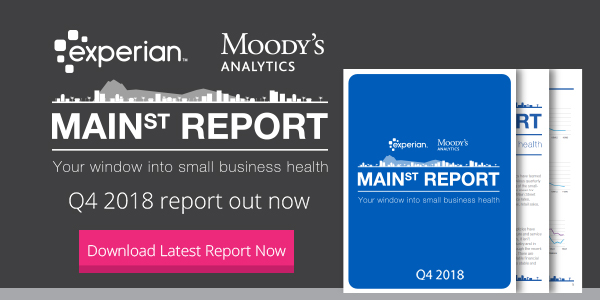
Experian has released the Experian/Moody's Analytics Main Street Report for Q4 2018. The report brings deep insight into the overall financial well-being of the small-business landscape, as well as providing commentary around what certain trends mean for credit grantors and the small-business community. Bucket 17Q4 18Q3 18Q4 Moderately Delinquent 31-90 1.68% 1.63% 1.68% Severely Delinquent 91+ 4.00% 3.40% 3.49% Bankruptcy BKC 0.16% 0.16% 0.16% The fourth quarter capped a second year of solid performance and growth for small-business credit, but there are signs that the period of moderation experienced during the past two years is over. Since the government shutdown has the potential to throw small-business lending a curve ball in the first half of 2019, the outlook for small-business credit is neutral. Conditions were positive in the fourth quarter, but this may not last long. Delinquency rates remained mostly stable, with pockets of weakness spread out among regions and industries, notably construction in the Plains. In addition to the 35-day shutdown, rising interest rates, destabilizing trade policy and slowing home-price growth are potential trouble sources that are already starting to impact some regions.
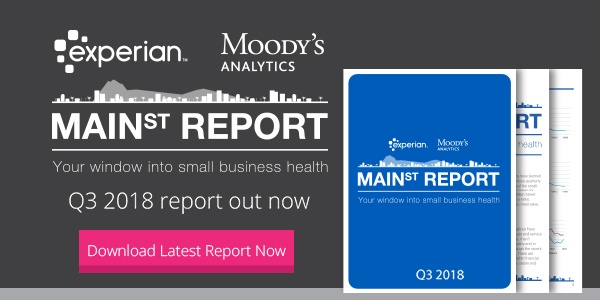
Today Experian and Moody's Analytics released the Q3 2018 Main Street Report. The report brings deep insight into the overall financial well-being of the small-business landscape, as well as providing commentary around what certain trends mean for credit grantors and the small-business community. For Q3 2018, the overall outlook for small-business credit is positive, but some industries such as construction have a negative outlook. Delinquency rates stable for now Delinquency rates are stable around their current levels, but this could change quickly if risks mount for certain industries. Continuing strength in the economy should keep small-business credit performance in check through the fourth quarter and early next year. Rising interest rates, destabilizing trade policy and slowing home-price growth are potential sources of trouble that are already starting to impact some regions. To bring insight to these Q3 business credit findings, Experian and Moody's Analytics will be presenting the Quarterly Business Credit Review for Q3 2018 on Tuesday, December 11th 10:00 a.m. (Pacific) 1:00 p.m. (Eastern). Read the report and bring your questions, we will be opening up the session for live Q&A as we dig into the numbers and the outlook for Q4 2018. We hope to see you there. Presenters: Gavin Harding Derrek G. McCrank Cristian deRitis
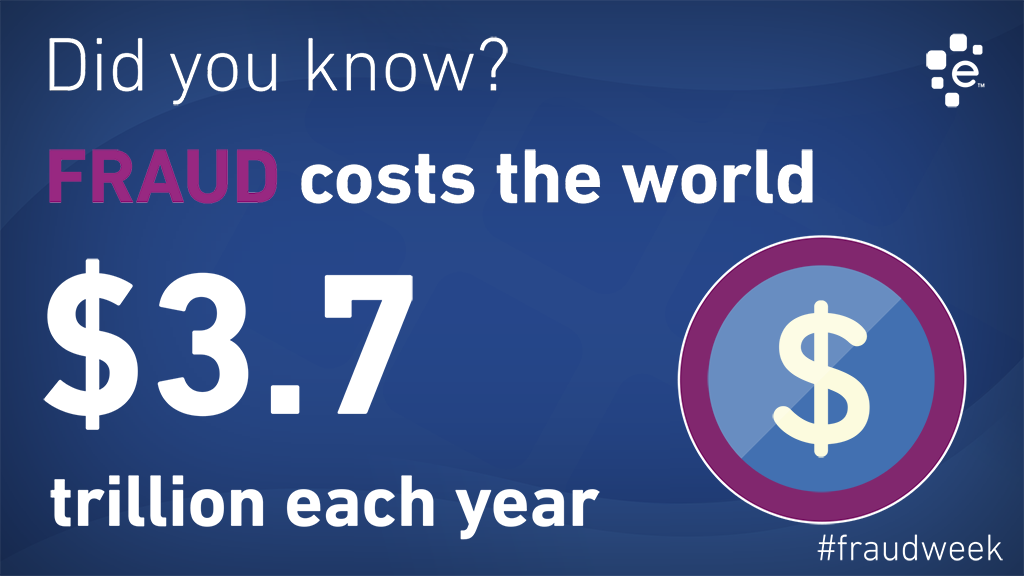
It's International Fraud Awareness Week and Experian would like you to know how big the problem is for businesses. Here are some sobering facts, did you know? Every year 3.7 trillion dollars is lost to fraud? it would take the average person to spend 130 million dollars per day in their lifespan to cover that amount. Fifty four percent of businesses are only "somewhat confident" in their ability to detect fraudulent activity. And that's compared to only 40 percent who are very confident. 52 percent of businesses have chosen to prioritize the user experience over detecting and mitigating fraud. Organizations worldwide lose an estimated 5 percent of their annual revenues to fraud, and an incident of fraud costs a company a median loss of $145,000. .
